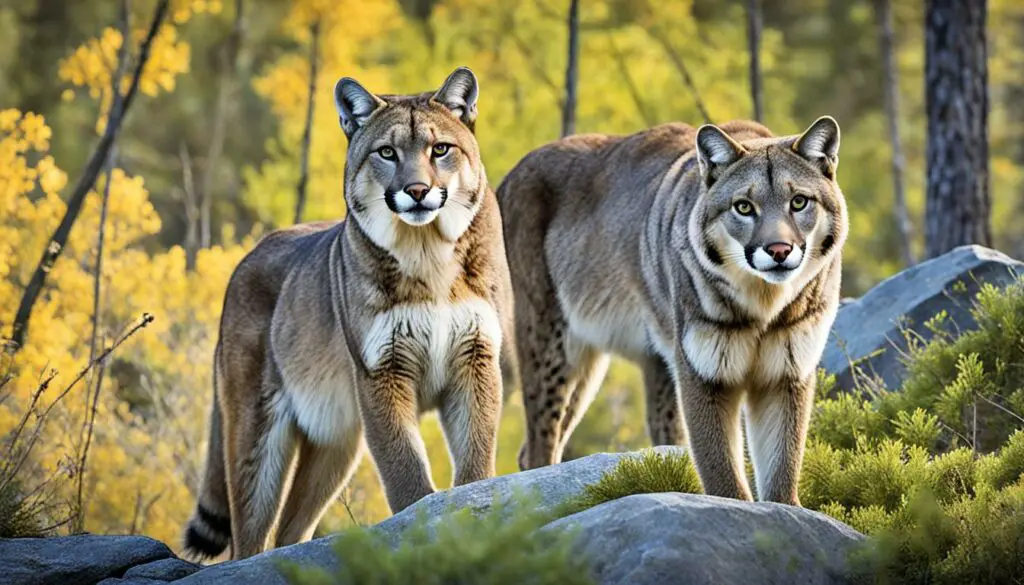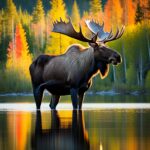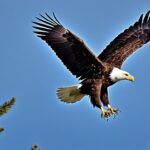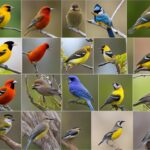Have you ever wondered if wild cheetahs live in the U.S.? The idea of meeting one is exciting. But, no wild cheetahs live in the USA now.
The USA has its own big cats like mountain lions and bobcats. But, a long time ago, the American cheetah did live here. Now, if you see a cheetah in the U.S., it’s likely in a zoo or a reserve.
The History of Cheetahs in North America
The American Cheetah, known as Miracinonyx, lived in North America during the Pleistocene. This period was about two million to 11,700 years ago. It was a time when many big animals, known as megafauna, roamed the Earth.
Extinct species: The American Cheetah (Miracinonyx)
The American Cheetah Miracinonyx covered species such as M. inexpectatus and M. trumani. They shared their space with creatures like mammoths and saber-toothed cats. These cheetahs had unique ways of catching food, different from modern cheetahs.
Pleistocene Epoch and cheetah evolution
The Pleistocene time greatly shaped cheetahs. It caused the American Cheetah Miracinonyx to develop special traits. They likely hunted and survived in ways that today’s cheetahs do not.
Fossil discoveries and what they reveal
Fossil finds in places like the United States and Mexico show us how ancient cheetahs lived. These remains help us learn about American Cheetah Miracinonyx’s looks and life. They add to our understanding of cheetah history.
| Feature | American Cheetah (Miracinonyx) |
|---|---|
| Epoch | Pleistocene Epoch |
| Species | M. inexpectatus, M. trumani |
| Hunting Strategy | Potentially less reliant on speed |
| Key Fossil Sites | Various points in the United States and Mexico |
Understanding the Modern Cheetah: Acinonyx Jubatus
The modern cheetah, known as Acinonyx jubatus, is the fastest land animal. It has a lean body and long legs, making it nature’s sprinting champion. Chiefly, it can reach extraordinary speeds in short bursts.
Evolution and Classification
Across time, the modern cheetah, Acinonyx jubatus, has developed distinctive features. These include non-retractable claws and a skeleton for swift movement. These unique traits make the cheetah stand out among large felines.
Current Habitats and Ranges in Africa and Iran
Cheetahs’ main habitats are in Eastern and Southern Africa, where they have space to roam. A few also live in Iran. There, conservation efforts aim to safeguard their future. Yet, both in Africa and Iran, the places cheetahs call home are shrinking, making survival hard.
Are there wild cheetahs in the USA?
Contrary to myths, wild cheetahs in the USA don’t exist today. Some say they’ve seen cheetahs in the country. But these are usually mistakes or cheetahs from private places. The last time wild cheetahs were here was during a time called the Pleistocene Epoch. Then, there were American cheetahs, but they’re gone now. It’s vital to know the truth to see America’s wildlife clearly.
Many find the idea of wild cheetahs in the USA fascinating. But cheetah sightings here are very rare. They’re mostly in places like zoos and wild reserves. Fossils and controlled areas show where cheetahs have really been. This clears up the myths.
Knowing the truth is good for protecting cheetahs worldwide. Our interest in them remains strong. Yet, we must look at the real evidence and not get lost in myths. So, myth or reality, the idea of wild cheetahs in the USA is just a myth. It comes from mix-ups or past mistakes.
The Role of Zoos and Safari Parks
Zoos and safari parks help save cheetahs in the U.S. One important place is the Virginia Safari Park. It has several cheetahs living there.
Virginia Safari Park and its Resident Cheetahs
The Virginia Safari Park is special. Here, you can see not only regular cheetahs but also King Cheetahs. These cheetahs teach people about them and help in saving their kind. The park works with groups that protect animals to make sure cheetahs are safe.
Conservation Efforts within the USA
In America, many places work hard to protect cheetahs. They join with groups worldwide, like the Cheetah Conservation Fund. Together, they do things like making more cheetahs, studying their DNA, and saving their homes. The Virginia Safari Park is a big part of this. It shows how important these places are in saving wild animals across the earth.
Educational Programs and Their Impact
Learning programs at zoos are key in telling the public about saving cheetahs. Virginia Safari Park has fun and informative displays, talks, and tours. Their goal is to share with visitors why it’s crucial to keep cheetah homes safe. And to get everyone to help with saving these animals.
| Facility | Programs | Impact |
|---|---|---|
| Virginia Safari Park | Interactive exhibits, guided tours | Increased public awareness and support for conservation |
| National Zoos | Educational talks, special events | Enhanced community engagement and knowledge |
| Safari Parks | Collaborative programs, volunteer opportunities | Strengthened conservation initiatives and research |
Non-native Species in the United States
Non-native species, also called invasive species, create big problems for wildlife in the USA. They can come into new areas on purpose or by mistake. These newcomers can disturb the balance of nature. They fight with local species for food and places to live, hurting the variety of life that’s native.
It’s key to carefully manage these species to keep nature in check. We need to stop them from getting into new places and deal with the ones already here. By doing this, we help protect the wildlife in the USA.
We must understand how non-native species hurt the places they invade. This shows the real importance of working to save our wildlife in the US. Sharing clear rules and making people aware can help lessen the harm of these invaders on our lands.
Cheetah Conservation Status Globally
The global cheetah conservation status shows us the challenges in saving these amazing animals. Despite many efforts, cheetahs are in danger because of various threats.
Threats to the cheetah population
Habitat loss is a big danger to cheetahs. This loss happens because of people moving into their lands and farms growing. The cheetahs also face danger from people and get targeted by hunters. All this makes them a vulnerable species.
Conservation efforts worldwide
There are big efforts to protect cheetahs globally. Projects like making protected areas and fighting against illegal hunting are helping. For example, the Cheetah Conservation Fund works to breed more cheetahs. They also teach people how to live safely near these animals.
Success stories and ongoing struggles
Some places have seen good results in saving cheetahs. But, we still need to work hard and together. This way, we can make sure cheetahs are still here for our children to see.
Cheetah Sightings in America: Myth or Reality?
Many talk of cheetah sightings in America, sparking curiosity. But these stories usually don’t have solid proof. While rumors might spread, the idea of seeing a cheetah in the wild in the United States comes more from wild cheetah urban legends than real sightings.
It’s crucial to think about a few things when we look at these alleged sightings:
- Often, what people see might not actually be a cheetah. Mountain lions and bobcats are similar in size and shape. So, they can easily be mistaken for cheetahs.
- Now and then, a cheetah might escape from a small zoo or private collection. But, these events are rare and get solved quickly once the animal is found.
This table shows why discussions about cheetah sightings in America often lead to comparisons with wild cheetah urban legends:
| Aspect | Claim | Reality |
|---|---|---|
| Location | Wild in various states | Confined to zoos and private collections |
| Population | Estimates of small, hidden populations | No evidence of breeding populations |
| Witness Reports | Frequent accounts of sightings | Often misidentifications or myths |
While the dream of seeing a cheetah in the wild in the U.S. is exciting, it’s mostly just that, a dream. The real trick is figuring out what’s fact and what’s fiction when these cool stories get shared.
Comparing King Cheetahs and Standard Cheetahs
The difference between King Cheetahs and standard cheetahs is a hot topic. For cheetah lovers and researchers, it’s especially interesting. Both kinds have their own special features. But the King Cheetahs really catch our eye because of their unusual coat patterns. These come from a rare genetic change.
Unique Coat Patterns and Their Rarity
King Cheetahs are famous for their unique coat patterns. They look very different from normal cheetahs. Standard cheetahs have small, regular spots. But King Cheetahs have big, connected patches that look like stripes. This rare genetic change gives King Cheetahs their unique look.
You might not see King Cheetahs in the wild often. Most are found in places like wildlife reserves.
Behavioral Differences
There isn’t as much known about how King Cheetahs act compared to the others. What we do know is they seem to behave similarly when it comes to hunting and how they get along in their groups.
But, studying King Cheetahs in places like Virginia Safari Park can teach us a lot. It’s interesting to see if their special coat patterns affect how they act. So far, we’ve found only small differences in their behavior.
| Aspect | King Cheetahs | Standard Cheetahs |
|---|---|---|
| Coat Patterns | Large, connected patches resembling stripes | Smaller, evenly distributed spots |
| Rarity | Extremely rare | More common in the wild |
| Behavior | Similar to standard cheetah behavior; limited data available | Extensive observations available |
USA Wildlife Facts: Native Carnivores
The United States is home to a range of carnivores. Among them are mountain lions and cougars, key members of the ecosystem. They live in places like forests, mountains, and grasslands.
Mountain lions, cougars, and other native big cats
Mountain lions, or cougars, are famous cats in the USA. Besides them, there are many other important big cats. It’s vital to protect these animals from losing their homes to human developments.

Habitats and population data
These majestic animals live in large areas. Cougars can be found in both deep forests and high mountains. Knowing how many there are is key to protecting them. This helps them survive threats like losing their homes and human growth.
| Big Cat Species | Main Habitat | Estimated Population |
|---|---|---|
| Mountain Lion | Forest and Grasslands | 20,000 – 40,000 |
| Cougar | Mountains | Unknown |
| Bobcat | Various (e.g., Desert, Forest) | Unknown |
Historical Context: The Extinct American Cheetah
The historical context of the extinct American cheetah shows us a unique time. In the past, these amazing felines, known as Miracinonyx, lived in America. Even though these cheetah-like cats are no longer around, they have left their mark through fossils.
These ancient remains tell us a lot. They show us what the extinct cheetahs looked like and how they may have hunted. They also help us imagine what ancient North America was like, filled with big animals.
| Species | Characteristics | Adaptations |
|---|---|---|
| Miracinonyx inexpectatus | Slightly larger and robust compared to modern cheetahs | Adapted for endurance running |
| Miracinonyx trumani | Physically resembles modern cheetahs | Likely adapted for sprinting |
Studying Miracinonyx helps us understand more than just these cheetahs. It also shows us how the big cat family tree evolved to what it is today.
Challenges and Opportunities in Cheetah Conservation
Cheetah conservation faces lots of tough challenges that need everyone’s help. Human-wildlife conflict is a big problem. It happens when cheetahs get too close to farms or people’s homes. Sadly, this often leads to cheetahs being killed.
Human-wildlife conflict
The fight between humans and cheetahs is because cheetahs lose their homes. More people means less space for cheetahs to live in peace. To solve this, we need to work closely with local communities and teach them about the importance of protecting cheetahs.
Protected areas and their significance
Setting up protected areas is critical for cheetahs’ safety. These areas keep cheetahs safe from poaching and other dangers. They allow cheetahs to live and breed in peace, supporting their future.
It’s clear that creating and looking after protected areas is key. This work helps cheetahs survive and grow in number. Everyone’s help, from local communities to strong laws, is vital. Together, we can protect cheetahs for tomorrow.
FAQ
Are there wild cheetahs in the USA?
No, there aren’t any wild cheetahs in the USA. You can see them in wildlife reserves and zoos though. In the wild, you’ll find animals like mountain lions and bobcats.
What is the history of cheetahs in North America?
Long ago, during the Pleistocene Epoch, the American cheetah lived in North America. Scientists found fossils of two American cheetah species: M. inexpectatus and M. trumani.
Are there any fossil discoveries that shed light on the American cheetah?
Yes, many fossil discoveries help us learn about the American cheetah. They come from various places in the United States and Mexico. These fossils show us how these cheetahs lived and what they looked like.
Where do modern cheetahs live today?
Today, most cheetahs live in Eastern and Southern Africa. There is also a small group in Iran. They like to be in grasslands, savannas, and open forests.
How do zoos and safari parks in the USA contribute to cheetah conservation?
Places like the Virginia Safari Park are doing a lot for cheetahs. They keep and care for cheetahs, even rare kinds like King Cheetahs. They also work with groups that protect cheetahs and teach people about cheetahs.
What are some examples of non-native species in the USA?
Some species in the US aren’t from there. For example, the European Starling was brought intentionally. The zebra mussel, on the other hand, got there by accident. These species can hurt the environment by competing with local wildlife.
What threats do cheetahs face globally?
Cheetahs are in danger due to many reasons. Their homes are being destroyed, they fight with people over land, and they are being hunted illegally. These issues make them a species that needs help to survive.
Are there any credible reports of cheetah sightings in America?
Sometimes, people say they saw cheetahs in the US. Unfortunately, there’s not enough real proof of this. These cases are usually just mistakes where people see other animals but think they’re cheetahs.
What makes King Cheetahs different from standard cheetahs?
King Cheetahs have a special coat pattern that makes them stand out. Not much is known about how they act differently from other cheetahs. But ones at Virginia Safari Park help study what they eat and how they behave.
What are some native carnivores in the USA?
In the USA, animals like mountain lions, cougars, and bobcats are native. They’re at the top of the food chain in their areas. These animals are key for keeping nature in balance.
What can we learn from the extinct American cheetah?
Studying the American cheetah tells us a lot about the past. We learn about ancient environments and how big cats evolved. Fossils show us what the American cheetah looked like and how it might have hunted.
What are the main challenges and opportunities in cheetah conservation?
Protecting cheetahs is hard because of conflicts with people and losing their homes. But, making safe spaces and working with communities can help. These ways can save the cheetahs.







